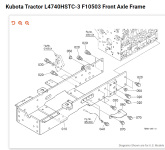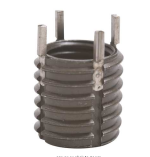Feel free to expound if your typing is up to it. You are becoming a valuable resource.
Ok, I guess I can expound a bit. Typical threads are about 75% of the theoretical 100% thread size. When similar materials are used for both the fastener and the tapped part and if the fastener is threaded into the tapped part at least 1 1/2 times the diameter of the fastener, then the tensile strength of the fastener will be less than the force required to pull the fastener straight out of the tapped hole. So the fastener will break if pulled straight out.
But it gets better. If only 50% of the theoretical 100% thread exists the fastener will still fail before the threads. Of course these figures apply to properly cut threads, not torn threads. If the threads are formed then the strength goes up. There are taps that form the thread and they have different colloquial names, such as roll taps or form taps.
Some materials, especially materials that tend to tear when a cutting tap is used, such as mild steel, are best for thread forming taps. Generally, stainless steels are good for formed threads. Brass and cast aluminum are usually lousy for form tapping, most cast iron alloys too. These material can be great for cutting taps because they make nice and small tightly curled chips. This feature means that the material doesn't form easily because of low ductility, so the formed thread will have lots of tiny cracks in it, which of course weakens the thread.
The type of insert the OP wanted to use in the first post only has about 50% thread. This doesn't matter because of the aforementioned reasons and is an advantage because it makes the minor diameter larger, strengthening the insert. And since the insert is in a tapped hole that is much larger than the fastener but only needs to be as strong as the original tapped hole there is another advantage because the much larger area of the insert outside diameter spreads the load over that larger area. And even though I don't know for sure it is very likely that the insert is made by forming the thread, not cutting it.
Besides the advantage of formed threads being stronger they are also easier to make because no chips are made during threading. So if the material can be formed it usually is. If you go to the hardware store and look at some grade 8 socket head cap screws, Allen head screws, you will see rolled threads. These formed threads are pretty easy to spot. Where the thread ends and there is an un-threaded portion of the screw, you can see that there is a reduction of the shank diameter just before the threads start. This reduction is not abrupt, like a machined relief, but gradual, at maybe a 10 degree slope. This is because the screw has two diameters before threading. The formed thread needs the smaller diameter because it forms the thread into peaks and valleys without removing any material. The thread will also usually have a better finish than a cut thread. Now I've had enough typing.
Cheers,
Eric

